Art has the universal power to speak to people across borders of culture, race and language. SOS ART Cincinnati, an organization promoting peace and justice through art, uses this ability of art to create bridges between people. A case in point is the recently inaugurated “Human Rights/ Derechos Humanos” exhibition at Xavier University.
The exhibition emerges from the portfolio of woodcut prints focusing on human rights created by 25 artists from the cities of Cincinnati and Oaxaca (Mexico). While earlier this year the Fitton Center hosted an exhibition displaying the prints from the portfolio, the current exhibition offers a broader artistic panorama. This is because the exhibition features the works that each artist created for the portfolio and also other works that illustrate their broader artistic practice. Saad Ghosn, who is the curator of the exhibition, explains the idea behind the initiative “This exhibition is in line with SOS Art’s mission to encourage and provide opportunities to artists to use their art as their voice for peace and justice. I wanted to hear the voice of artists from both Oaxaca and Cincinnati on the topic of human rights and create a collaboration across different cultures that would also reflect their specific art and cultural response.” To make this project possible, he worked with Ivan Bautista, one of the participating artists and also the co-owner of Taller Burro press in Oaxaca, who contacted selected artists from the city. Subsequently, SOS ART and the Taller Burro Press worked together interacting and coordinating with artists, thereby creating collaborative networks between artists and institutions across regions.
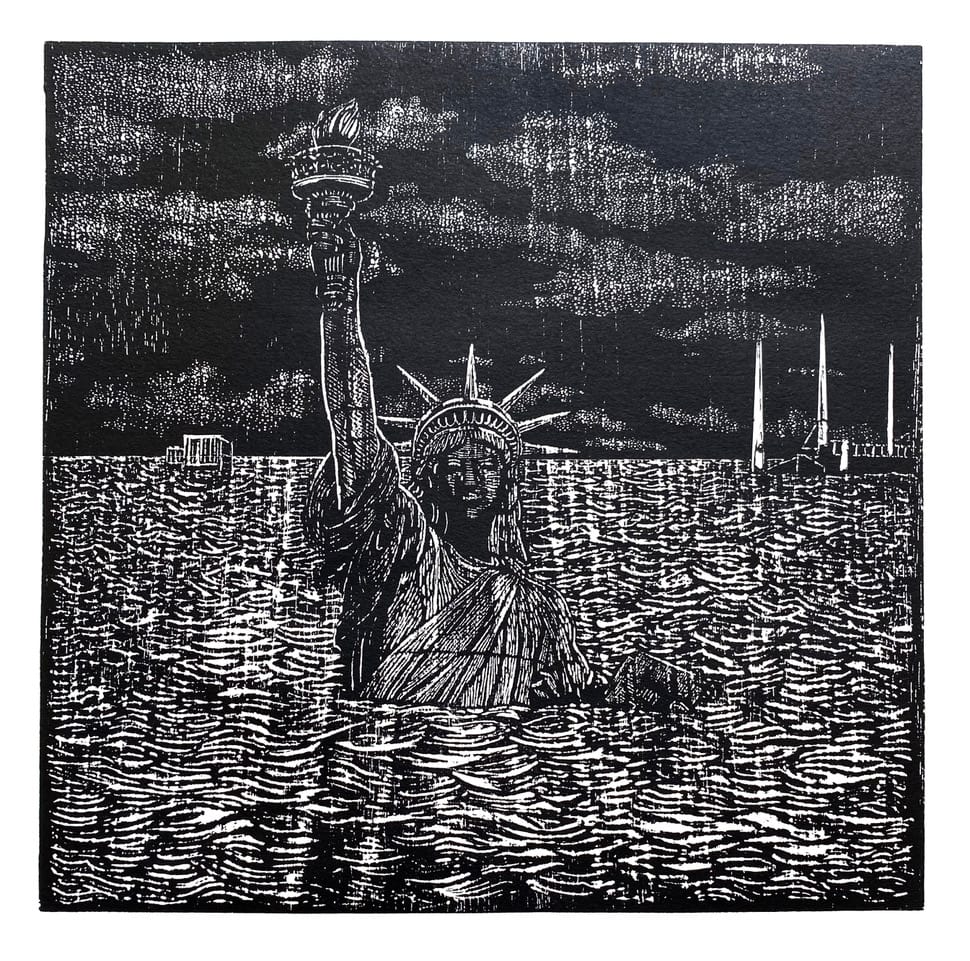

Like many other initiatives by SOS ART, the idea of diversity is at the heart of the Human Rights exhibition. Saad Ghosn elaborates, “the selection was based on the artistic merit of the artists, also on their diverse styles and diversity in general. I was hoping for a balance of men/women artists in both cities.” There is also thematic diversity as the exhibition, particularly the portfolio, covers a wide panorama of subjects – such as the right to democracy, health, freedom, home, justice, equality and so on. Furthermore, diversity in artistic approaches is also evident. Since artists, one from Cincinnati and the other from Oaxaca, have both responded to one of the twelve human rights as declared by the UN, the distinctiveness of each artist’s work becomes obvious when two artists approach the same theme. For example, in his work Mark Patsfall portrays a sinking statue of liberty to convey that “Climate change is the biggest threat to everyone’s liberty”. When Darío Castillejos Lázcares from Oaxaca responds to the same right to freedom, he gives a different slant. Depicting a bird sitting gloriously free atop a mountain of cages, he says that the work “represents the battle of each being in search of his freedom. Without a doubt, the fighting spirit and spiritual strength are essential requirements to obtain it, but also the awareness of our own fragility which helps us understand that it is with our strength, but also with faith, that we can obtain victory, raising our wings towards a sky of infinite possibilities.”
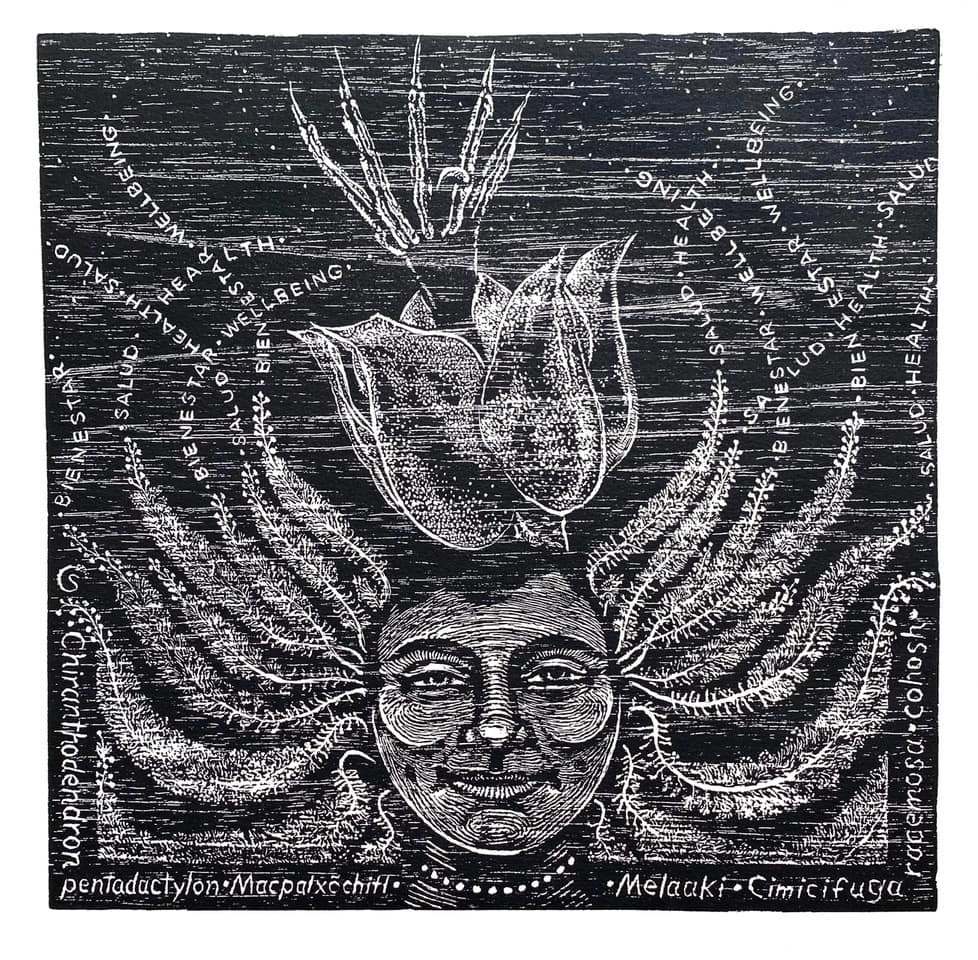
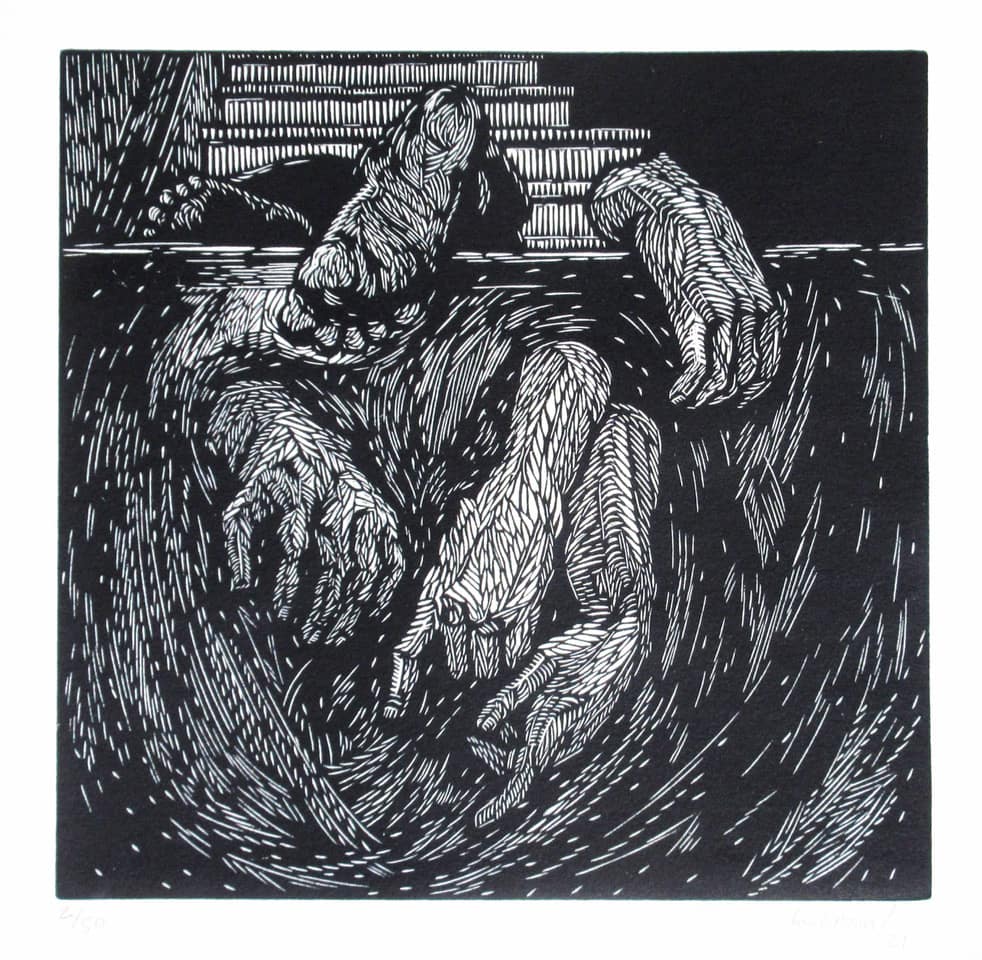
In interpreting the various rights, artists draw from broader social, political and cultural developments and also from their own roots. A case in point is Suzanne Michele Chouteau’s work on the right to health; it weaves together ideas on health, traditional knowledge, ecology, the treatment of indigenous peoples and personal history. Regarding her print that visualizes a female form with organic elements she says, “Throughout the Americas indigenous people have practiced holistic healing with plant-based medicines, but their life-ways have been continuously threatened or completely annihilated by imperial, colonial forces. In Oaxaca, the flowers of Macpalxochitl (Nahuatl for palm flower), árbol de las manitas (Spanish) or Chiranthodendron pentadactylon are effective to treat diarrhea, dysentery, and stomach pain particularly in children. I am a member of the Shawnee Tribe whose family members were forcibly removed from Ohio c. 1833…The Shawnee’s medicinal plant knowledge was renowned and valued by numerous other tribes. They used Melaaki (Shawnee for snakeroot), cohosh (Algonquin) or Cimicifuga racemosa to treat fevers, particularly in children, and also to treat depression in adults by boiling it into a tea…. Melaaki has had particular significance in my own health as an alternative to the hormone therapies, anti-depressants and other drugs that doctors typically prescribe…” Yet another impactful work from the portfolio is “Trabajo (Work)” by Mario Guzmán Olivares. This depicts the hands and feet of workers— weathered, worn-out and exhausted— to make a strong statement against capitalism that exploits many for the benefit of few.
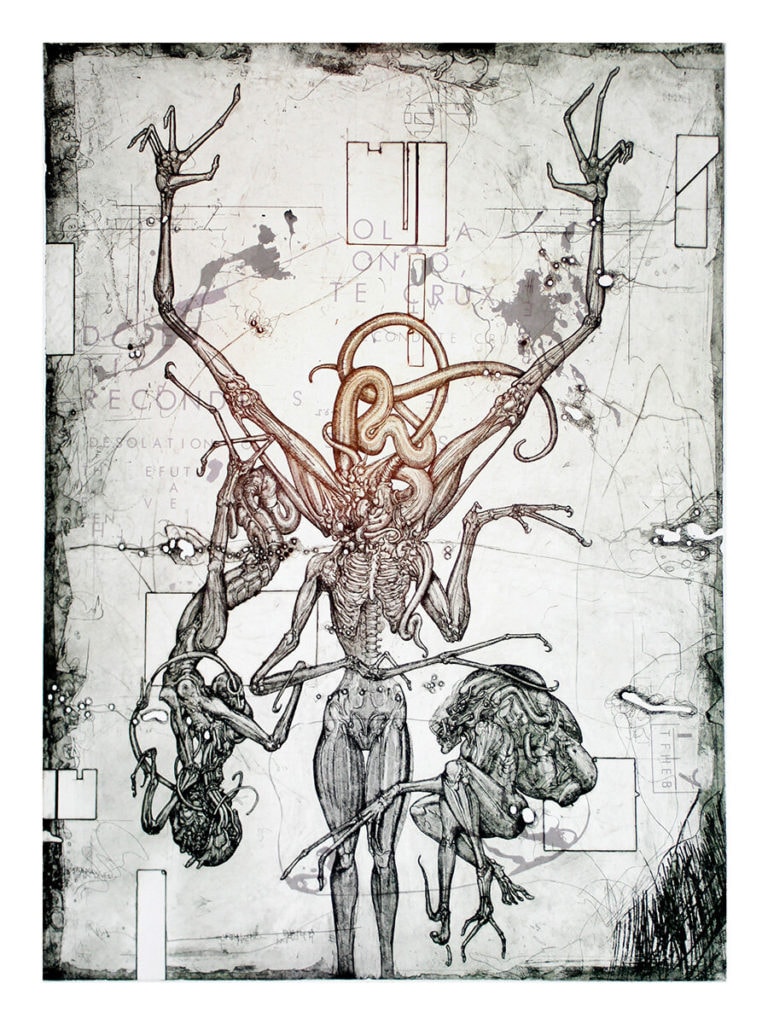
Etching, aquatint, silkscreen
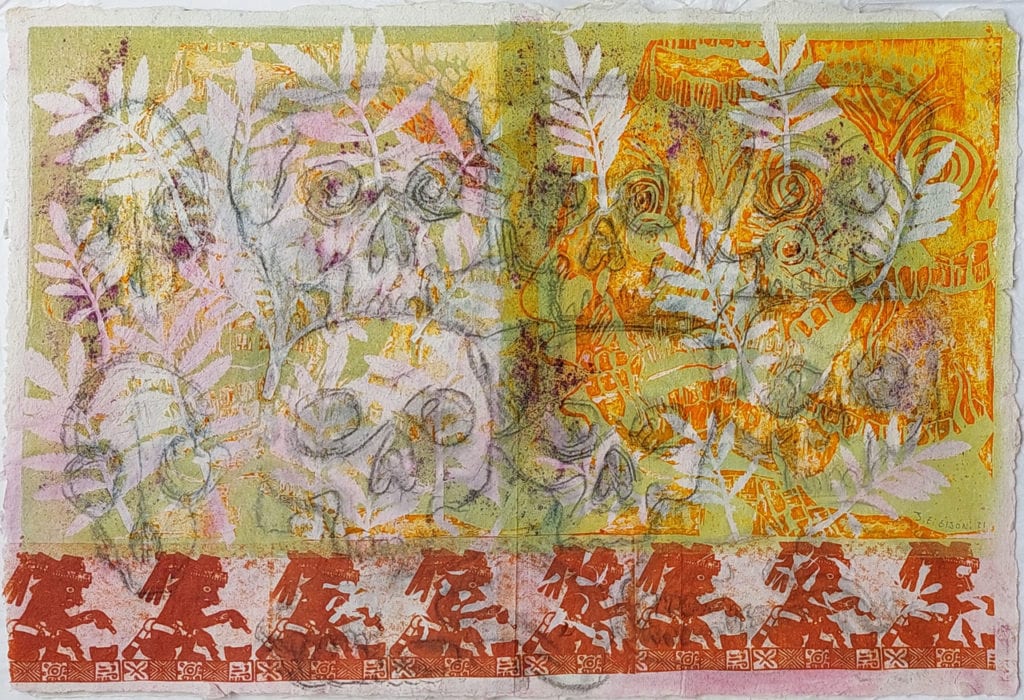
Adding an interesting counterpoint to the works from the portfolio are the 50 prints, two by each of the artists, that represent their work in general. This helps us observe points of overlap and departures between the works done for the portfolio and their general artistic practice. For example, Ken Swinson’s cover page for the portfolio is stylistically related to his general body of works. In contrast, Enrique Gijon’s work “No Discriminación” is different in spirit from the other works “Polinizador (Pollinator)” and “Tzompantli” that are also displayed in the exhibition. In the latter two works, the artist creates a culturally and artistically rich tapestry of imagery by drawing from aspects of Mexican culture and religion. Andrew Au’s work is also fascinating for its thought-provoking concept and visual language that incorporates surreal organic elements. The artist explains: “My 2 prints are from ‘The Future Has Ever Been’ Series which focuses on the idea that the future has already been written, in terms of how human nature is dictating our reactions to it. A bit fatalistic, the prints from the series explore ideas of technological advancement at the expense of humanistic values, an unwillingness to alter course to protect our environment, and a stubborn adherence to magical thinking.” These works, as also many other works in the exhibition, make a strong impact in the viewer’s mind for they nudge us to recalibrate the way we approach our life and the world around us.
The “Human Rights/ Derechos Humanos” exhibition features the works of 12 artists from Oaxaca: Iván Bautista, Baltazar Castellano Melo, Darío Castillejos Lázcares, César Chávez, Edith Chávez, Alberto Cruz, Enrique Gijón, Xabier R. González, Mario Guzmán Olivares, Silverio Herrera, Felix Monterrosa, Shinzaburo Takeda and 13 artists from Cincinnati: Andrew Au, Suzanne Michele Chouteau, John Hankiewicz, Kevin Harris, Theresa Gates Kuhr, Julie Lonneman, Susan Naylor, Mark Patsfall, Jennifer Purdum, Kate Rowekamp, Jonpaul Smith, Ken Swinson, Roscoe Wilson. The works of these artists offer us food for thought by creating awareness on the important subject of human rights and also on several other social and political issues. At the same time, the exhibition is also a visual treat as the artists have created works that are rich in form and content. An exhibition of rare depth and substance, it is a must-visit for everyone!
The exhibit will be on view until September 23, 2022, Monday to Friday 10am to 4pm
Xavier University Art Galleries, A.B. Cohen Center, 1658 Musketeer Dr, Cincinnati, OH 45207.